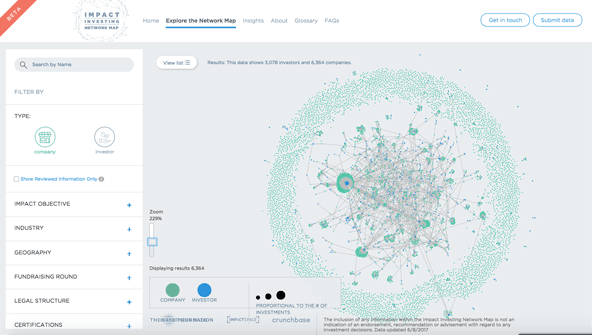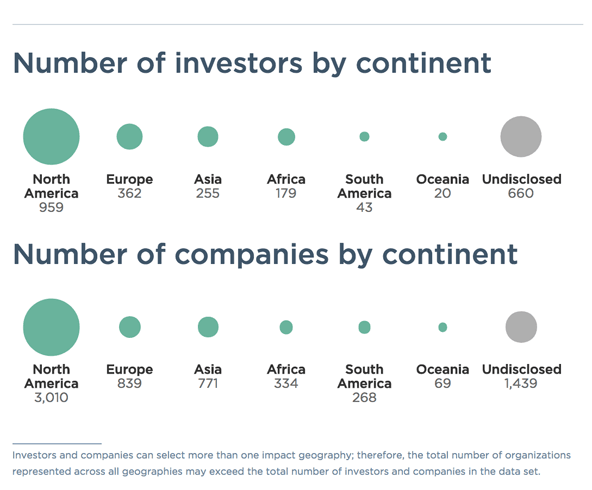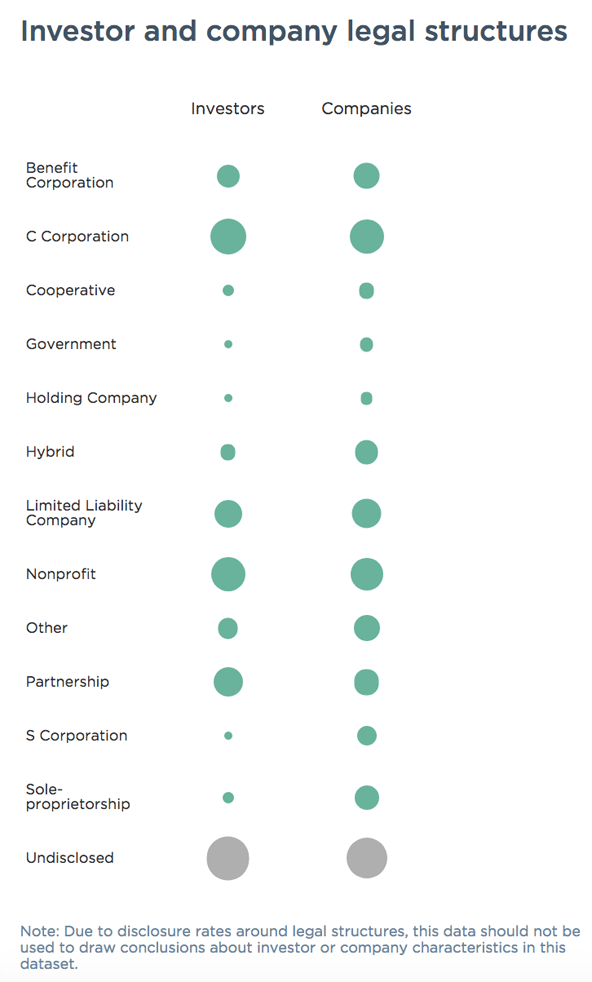 Map view of the Impact Investing Network Map. (Image by Case Foundation)
Map view of the Impact Investing Network Map. (Image by Case Foundation)
Impact investing is steadily moving from a niche market to mainstream. In previous articles, I’ve both spoken of some of the myths and barriers holding the movement back, as well as trends that will drive scale and take impact investing to the next level. Now, as the movement seeks to put trillions of dollars to work to deliver both social and financial returns, I look to what is needed most to propel it to the next phase, and the answer is abundantly clear: data.
To date, efforts to make a case for impact investing have focused on a limited number of companies and anecdotal narratives on the benefits of impact investing. There are numerous such stories, and each is playing an important role in moving impact investing forward. I am particularly proud of the leadership shown by the National Geographic Society in committing five percent of its endowment to impact investments, furthering the organization’s commitment to understanding our planet and generating solutions for a healthy, more sustainable future. And all in the sector tip our hats to the steps the Ford Foundation has taken recently in this field, and its recent commitment of $1 billion over 10 years is the kind of “big bite” the movement needs to scale.
As is the case with any system-disrupting innovations, these stories help engage early movers. But to enter the mainstream, impact investing requires accessible and reliable data that demonstrates the breadth of the field, along with the return and impact spectrum it offers. At present, public data collection and management practices are implemented too haphazardly. Even in instances where a company or an investor has shared some data, a lack of clear industry standards for categorizing it hampers consistency from one platform to the next.
To truly change this requires a broader behavioral shift across the industry—one that disrupts current behavior around a lack of disclosure, limited transparency, and underdeveloped standardization. On this point, history teaches. When venture capital was in its early days, there were “true believers” and others who were comfortable putting a portion of their capital at risk in a then-new, unproven asset class. But it wasn’t until institutions made investments in venture capital—particularly pension funds—that the industry moved to the mainstream. And it wasn’t until there was clear data from this growing field that the institutions jumped in.
Are you enjoying this article? Read more like this, plus SSIR's full archive of content, when you subscribe.
The most common question I hear when out speaking about impact investing is a simple one: Who has done what in this space, and what do we know about performance? In a nutshell, this is why the Case Foundation, working with partners across a broad spectrum of the impact investing ecosystem, built an Impact Investing Network Map—a tool we hope will help answer these questions over the coming years.
The map demonstrates the publicly available transactions between investors and companies within impact investing. We believe that by bringing the connections between actors to life—looking specifically at the investments that connect them—we can foster a better understanding of the size, breadth, depth, and, importantly, the enormous potential of this field.
But as early explorers like Columbus and Magellan discovered, a map is only as good as the data used to create it. We need accurate data, reliable data, sharable data, standardized data—and the more data the better.
Data platforms ImpactSpace and Crunchbase have been a critical part of our early exploration at Case Foundation, serving as our data partners. At the outset of this endeavor, we understood the challenges we would face together—that the data we had was the best available in terms of transparency and accessibility. We also knew there would be information gaps across the ecosystem. But we hoped enough information would surface to allow users to see the ultimate vision and utility of the final product—that, with the available data, the map would allow the sector to begin to answer questions like:
- Who are the industry investors and companies?
- How are they defining the impact they were trying to have?
- What sectors have been most robust?
- Are certain regions or markets emerging to reflect most of the deal flow?
- What is the stage or scope of investments?
Ultimately, we want to be able to look at field-wide patterns to show current and prospective investors where the activity has been by investor, geography, investment round, impact objective, and so on.
Get on the map
We see filling in data gaps as an actionable challenge to take on. And it is why we are launching a call to action to the entire impact investing community, asking them to push for transparency in data and to input their data. To get on the map.
Consider the art of the possible here. Let’s look at the preliminary data from the map as we explore geography. In this case, geography represents the location where an investor or company intends to focus its efforts—the “impact geography.”
 Sample representation of the geographic data in current Impact Investing Network Map dataset. (Image by Case Foundation)
Sample representation of the geographic data in current Impact Investing Network Map dataset. (Image by Case Foundation)
According to our dataset, we can account for geography for only about 58 percent of the included companies. And yet we know from our own work that many entrepreneurs and investors are rigorous about where they look to have the most impact. They identify the interventions they believe in, based on the communities they hope to work with, their understanding of the financial prospects of new markets, and the multiplication effect of creating enabling environments. In some cases, there’s a lack of disclosure. But in other cases, companies have shared the information about the geographies of their investments, yet a lack of consistent taxonomy means the data is not easily displayed across multiple platforms.
Or let’s take investor and company legal structures:
This time, our dataset suggests that only 33 percent of investors and 25 percent of companies disclosed their organization’s legal status. With the growth of benefit corporations and other innovative legal structures and certifications (such as B Corps), transparent and comprehensive information on the map would show the world a lot more about how companies and investors organize themselves to maximize social and financial returns.
 Sample representation of the data on investor and company legal structures in current Impact Investing Network Map dataset. (Image by Case Foundation)
Sample representation of the data on investor and company legal structures in current Impact Investing Network Map dataset. (Image by Case Foundation)
These are just a few of the many examples we can point to after our first data run. The inability for investors to tangibly see what completed investments look like and the specifics around how they were made hinders growth of the impact investing industry and brings unnecessary opacity.
A call to action
We think there is an extraordinary opportunity to move the needle here, and to bring industry players and prospects the valued data they want and need. The map is not intended an advisory tool, but rather as a way to see the ecosystem more broadly—an important tool and first step into the next phase of the impact investing movement.
For all those active in the impact investing space, the clarion call is simple: #ShareYourData. As true followers of the nascent impact investing movement, it is your early activity and data—made transparent—that will propel the drive to mainstream. We truly believe increased sharing of data and better mapping of the ecosystem will result in more robust activity from investors and entrepreneurs. Simply put, using data to inspire and educate both new and experienced actors holds the promise of larger capital flows toward impact.
Here’s how you can be a part of this change:
a) #ShareYourData. Visit our data partner, ImpactSpace, to submit your data today.
b) Spread the word. Share this call to action with your network and encourage others to join the movement.
c) Be a part of early testing. Stay informed by signing up and telling us if you want to be a data provider, beta tester, or interested changemaker.
We encourage you to #ShareYourData and join us in moving impact investing forward.
Support SSIR’s coverage of cross-sector solutions to global challenges.
Help us further the reach of innovative ideas. Donate today.
Read more stories by Jean Case.

